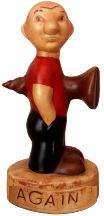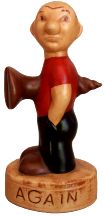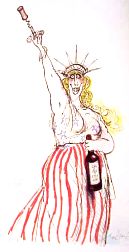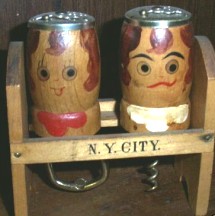 |
 The Virtual Corkscrew Museum's Weekly Newspaper |
 |
 |
 The Virtual Corkscrew Museum's Weekly Newspaper |
 |
|
Sunday, May 28, 2006 |
The Big Apple
New York, New York - So why is it called the Big Apple? Some link it to the sidewalk apple vendors of the Great Depression, others to a Harlem night club, and some to the "Big Apple" dance of the 1930s.
But the most likely source of the term comes from the jazz musicians of the 1930s and 1940s. In those days, if a jazz musician said he had a gig in the "Big Apple", all knew he was playing in the hot spot - Manhattan.

With a little effort, a corkscrew collector can build a good collection of New York City corkscrews. It is not hard to imagine visitors to New York taking the ferry to the Liberty Island and after ooing and awing over the statue, buying a Statue of Liberty corkscrew in the souvenir shop. It would be their remembrance of the lady standing in New York Harbor. She was a gift from France to the United States commemorating freedom and friendship between the nations. the statue was produced by Frederic-Auguste Bartholdi and dedicated in 1886.
Moving up Manhattan to the North, one finds the Empire State Building at 34th Street and 5th Avenue. The visitor learns that on January 22, 1930 the excavation for the building began. One year and forty-five days later it was complete. On May 1, 1931, President Herbert Hoover officially opened the building by ceremonially pressing a button in Washington, D.C. to turn on the lights.
The building is 1,454 feet tall. There are 102 floors and 6,500 windows. It held the record for being the largest skyscraper in the world for 40 years after it was constructed. The building has starred in over 90 movies with King Kong being perhaps the most remembered.
And after a tour of the building, who wouldn't stop in the gift shop? And some would purchase souvenir corkscrews. If one forgot, they could always stop in the F. W. Woolworth Co. five and dime, and purchase a corkscrew for 25 cents with an illustrated protected paper wrap on a sheath.
Even more exciting for the souvenir hunter would be a miniature version of the Empire State Building serving as the sheath for a corkscrew (pictured below).
In 1939 New York was home to the World's Fair. The memorable symbols on the fair were the Perisphere, the Trylon, and the Helicline. The Perisphere was a 180 foot spherical exhibit building. The Trylon was a 610 foot tall three sided obelisk. The Helicline was a 950 foot circular ramp which connected the Perisphere and the Trylon. Visitors could go home with a souvenir in the shape of the Trylon which was the sheath for the worm. It was an excellent complement to the Empire State Building corkscrew of the same type. Others might opt for the more amusing souvenir corkscrew pictured below.
In 1966, a major change to the New York skyline was begun. At the lower end of Manhattan, construction was begun on the World Trade Center began. By 1970, the first tower was completed and the second tower was ready for occupancy in January 1972.
Both World Trade Center towers had 110 stories. The North Tower was 1,368 feet tall and the South Tower was 1,362 feet tall. When completed they were the tallest buildings on Earth only to be outdone in 1973 by the Chicago Sear's Tower towering over Chicago at 1,450 feet.
The World Trade Center's 107th floor was home to an elegant restaurant called Windows on the World. The 50,000 square foot restaurant opened in 1976 in the North Tower. It was an important place for celebrations and in 2000, its last full year of operation, revenues were $37.5 million. The restaurant had a fabulous wine cellar appropriately name Cellar in Sky.
A one million dollar inventory of wine was lost with the collapse of the tower on September 11, 2001.
Yes, a visitor could dine at Windows on the World and leave with a waiter's friend souvenir of the visit.
A souvenir hunter might have enough pocket change left to purchase a cheap bar set with corkscrew and cap lifter mounted in a stand depicting not only the Statue of Liberty and the Empire State Building, but also Rockefeller Center. Rockefeller Center is a complex of 19 commercial buildings between 48th and 51st Streets in New York. It is located between Fifth and Sixth Avenues.
Few people haven't heard of it's most famous building housing the nation's largest indoor theater, Radio City Music Hall. The hall got its name from on of its first tenants, Radio Corporation of America (RCA). Would one rather ogle the Rockettes in the hall or look for souvenir corkscrews in the gift shop?
And if one didn't have any pocket change, a shopkeeper might part with one of these just for the asking!:

Elgin, Illinois - Joe Young reports "Ran across this corkscrew from our collection yesterday. Thought you may not have seen this before - the figural part is bronze? "I love NY" with the Statue of Liberty, Empire State Building and the Twin Towers."
A key corkscrew / opener from Rockefeller Center (Joe Young Collection).
Ontario, Canada - Reader Ron MacLean has his Big Apple souvenir:
Little Brown Church
Nashua, Iowa - In this little Midwest town of around 1600 residents, there is a Church called "The Little Brown Church in the Vale." In 1856, William Pitts, a music teacher, was passing through the area. He saw a vacant lot and dreaming when returning home, he wrote Church in the Wildwood". At that time Church members were meeting in various places about town. Rev. Nutting came to town arrived and under his guidance the foundation for the Church was laid in 1860. Building slowed throughout the Civil War and the building was finally complete in 1864. They began making plans to build a church. A family in the parish gave them the property. When Rev. Nutting arrived, talk of building became serious.
Limestone was quarried and by 1860 the foundation was laid. When Pitts returned, he was surprised to see the Church. He returned home, found his song, and it was sung at the dedication.
The town slowly disappeared when the railroad by-passed it and the flour mill moved. The Church building was closed in 1888 only to be used on rare occasion. It wasn't until the 1900s that the Society For The Preservation of The Little Brown Church was formed and in 1914 the Church re-opened to regular services.
The Church remains a healthy Church today.
Editor's Note: I wrote to the Little Brown Church and asked if they knew anything about the Flash Corkscrew picturing the Church. I received this reply from Rev. Linda:
"Since the church did not sell the souvenirs you mention at least in any records that I can find, it is really hard to determine a time frame. Throughout the history of the church from the souvenir black velvet pillow sold at the World's Fair in Chicago on down to the present ... we even found a wine bottle that included a glass etching of the church ... there has been little contact between those who produce and sell souvenirs and those who have anything to do with our little local congregation. Occasionally someone will actually ask but not very often. I wish you luck on your search. Rev. Linda"
Mystery Feedback
Germany - In the May 21 issue, Reader Bernhard Maurer of the Korkenzieher Museum Kaiserstuhl asked "Who can give me informations about this corkscrew (?). It is marked G. F. HIPKINS & SONS BIRMINGHAM. "
Readers have sent these comments:
White Plains, New York - Howard Waldman: "Who says its a cork remover? It looks more like a clam or oyster opener."
Staunton, Virginia - Bob Roger: "There was an early bung puller made for pulling barrel bungs that was shaped like a duck bill (curved) as Bernhard's example is shaped. It was called a bung tickler. The point was forced into the side of the bung (they weren't necessarily driven flush) and then used as a lever to 'tickle' the bung up. A similar application would work on corks like champagne or beer corks that weren't flush. But there would be no reason for a button on the shaft. Perhaps it is a cellarman's corkscrew that has been broken and someone has sharpened and bent the end to try it out?"
May 29 - Reader Richard Craven adds "The item looks as if it is made of steel. I have always understood that it is dangerous to open oysters with steel knives/points as it can cause a poisonous reaction, though stainless steel is OK, so unless this is stainless steel or silver I doubt it was for oysters."
May 30 - Reader Frank Ellis adds "I am convinced that this tool is for opening oysters as someone else has suggested."
Sheffield Knives
Cohasset, Massachusetts - Reader Kenn Cameron found an article in a June, 1884 Harper's Monthly Magazine which discusses knife making and the conditions in the factory. Click here for the PDF file (1+meg).
|
©2006 Don Bull, Editor |